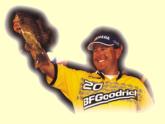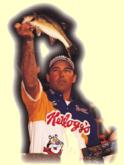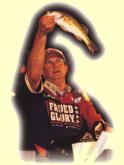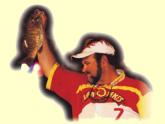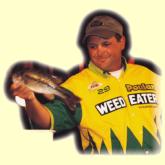Slightly Moore

Andre’s giant win at the Wal-Mart Open on Beaver Lake
The FLW Tour’s Wal-Mart Open might as well be dubbed the sight-fishing Super Bowl. Over the event’s five-year history, three Wal-Mart Open titles have been won by sight-fishing.
At first, it looked as if this year’s Wal-Mart Open might be different. Water levels began to rise several weeks before the FLW Tour arrived at Beaver Lake. A week before the tournament, the lake crested at nearly 10 feet over normal pool – the highest watermark Beaver Lake had experienced in decades.
Also, the water was cold. Five days before the tournament, the water temperature was still 50 degrees. Many pros thought the high, cold water would delay the spawn for a couple of weeks, but an unseasonable Ozark Mountain warm-up crept into the White River valley, and the lake’s water warmed quickly.
In five days, the water temperature rose nearly 15 degrees. When the final day of practice was over, many anglers were rigging up tube lures – a sure sign that bass were on bed.
The high water did change Beaver Lake somewhat. The White River was extremely muddy, and the mid-lake portions were stained. However, clear water still presided over the dam region. The result was that many sight-fishing anglers were packed into a much tighter clear-water zone than in years previous.
Additionally, the fish had many more places to hide. With 10 feet of water up on the bank and in the trees, bass were discovering new real estate.
Prevalent patterns
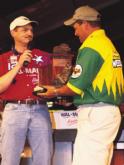 The high water provided some alternatives to sight-fishing for a few anglers. Stanley pro David Walker of Sevierville, Tenn., rode a flipping bite into the top 20. Broadway, N.C., pro Jeffrey Thomas discovered a spinner bait bite that put him into the top 10. Rob Harty of Sachse, Texas, cast a crankbait for a third-place finish.
The high water provided some alternatives to sight-fishing for a few anglers. Stanley pro David Walker of Sevierville, Tenn., rode a flipping bite into the top 20. Broadway, N.C., pro Jeffrey Thomas discovered a spinner bait bite that put him into the top 10. Rob Harty of Sachse, Texas, cast a crankbait for a third-place finish.
In the end, the Wal-Mart Open came down to another sight-fishing shootout. A couple of usual sight-fishing suspects, Kellogg’s pro Clark Wendlandt of Cedar Park, Texas, and Bernie Schultz of Gainesville, Fla., made the short-list, and two new faces on the Wal-Mart FLW Tour, Andre Moore of Scottsdale, Ariz., and Yamaha pro Dean Rojas of Lake Havasu City, Ariz., also brought their sight-fishing expertise to Beaver Lake.
Raising Arizona
Moore eventually outfoxed the field on the final day with a catch of 10 pounds, 6 ounces, and Rojas finished fifth. But these two anglers have something more in common than a top finish in the Wal-Mart Open: Both are from Arizona.
Isn’t it strange that two anglers from Arizona, who had never fished on Beaver Lake before, finished in the top five?
“Not really,” Rojas said. “Guys from the West are good sight-fishermen. The lakes out West are gin-clear, and that’s what we do in the spring – sight-fish. Sight-fishing on Western lakes is almost identical to sight-fishing on Beaver.”
In fact, Moore actually sight-fished a few days in Arizona to prepare for Beaver Lake.
“They were already on beds back home, so I went sight-fishing a few days before coming to Arkansas, specifically to get my eyes `tuned up,'” he said.
Moore said that growing up in California and living in Arizona has made him a threat to win any tournament where sight-fishing is a factor.
“I have learned to look for bedding bass in places most people would not consider – under floating piers, under lower units of pontoon boats, under jet-ski ramps,” he said.
Most of all, Moore has learned to look deeper for bedding bass that are difficult to see.
“When most people think of bass on a bed, they think about the backs of pockets, creeks and up shallow,” he said. “I look for deeper fish on the main lake.”
Rojas leaned on his Western sight-fishing expertise at Beaver Lake. Rojas qualified for the semifinals in 11th place and then helped raise the FLW Tour on day three with the day’s biggest weight of 10 pounds, 15 ounces.
It looked as if Saturday’s showdown would take place between Rojas and two-time Beaver Lake Champion Wendlandt, but Rojas came up short on day four, bringing in 8 pounds, 2 ounces.
Rojas offered no excuses for his catch. Even with a fog delay that left anglers only four hours to fish, he never got flustered.
“I fished a perfect tournament,” Rojas said. “I caught every fish I wanted to catch, and I never lost one. I just never found a big fish on the last day. It was just not my turn.”
Rojas used a variety of Lake Fork Tackle lizards (white) and a Hawg Caller Polly Wog (white) for the bulk of his catch. Rojas rigged a rod for every condition he would encounter during the day.
“I had rods rigged with 15-pound test Izor line and 3/16-ounce weights for fish that were bedding deep in open water,” he said. “I had heavy-duty flipping sticks with 25-pound test Izor line and 3/8-ounce weights to pitch on bass bedding in the thick tree limbs.”
Wendlandt, Beaver Lake’s pretournament favorite, made a serious run at what would have been a record third Wal-Mart Open title, but Wendlandt found his tournament-winning bass with only 10 minutes left on the final day. Luckily for the bass, he had to leave to make check-in on time.
“It hurt to pull up the trolling motor,” Wendlandt said. “I really felt that, with another 10 minutes, it would have bit. I needed a 3-pounder to win. I don’t know if the one I left was big enough, but I certainly would have liked to have found out.”
Wendlandt was actually fortunate to make it to day four. He nearly dropped the ball in the first hour of the first day of the tournament. He spent an hour on a largemouth bass that barely missed the Beaver Lake 15-inch keeper mark.
“I about lost the whole deal right there,” he said. “I spent my early draw on that fish, and I got burned. In fact, I only had one fish in the livewell at 12:30 that day.”
But Wendlandt “righted the ship,” as he called it, with a solid 3 1/2-pound largemouth that made up for his missing, fifth keeper.
The Beaver Lake sight-fishing master returned true to form on day two to take the lead. He found opportunity in the flooded bushes and trees on Beaver Lake by wrestling his way back into the flooded forest and finding fish others would not.
Wendlandt stayed true to his old, standby sight-fishing lures: gambler tubes in a variety of colors. He also used a Texas-rigged Gambler Swacky Worm on several occasions to entice reluctant spotted bass.
If sight-fishing had been outlawed on the last day at Beaver Lake, Harty would have won the tournament. He never weighed a single sight-bass all week. In fact, he never got close enough to the bank to see a bass on a bed.
“I don’t sight-fish. I don’t have anything against guys who do, but I just don’t do it,” Harty said. “I had to rely on my old, Texas roadbed pattern.”
Harty’s favorite bass-fishing technique is fishing crankbaits on submerged roadbeds. Consequently, when he got to Beaver and saw all the roads that terminated into Beaver Lake’s flooded shoreline, he was excited.
“I was fishing for bass that were still relating to the old shoreline. The ends of the roads I was fishing were in 10 to 12 feet of water,” he said.
Harty used a Norman Deep Little `N’ in a variety of colors.
“The colors were important,” he said. “I had four crankbaits in various red patterns, from Rayburn red to red crawfish. Red was a key to catching the bigger fish. I had used shad patterns earlier in the week, and they did not produce like the red ones.”
Stained water was another key to Harty’s catch. He fished in the midlake region where the water had more color in it.
Harty turned in limits each day that ranged from 8 to 10 pounds. On the last day, he gave the sight-fishermen a run for the $210,000 first prize with a catch of 9 pounds.
Randall Hutson used a “dirty” trick on his competition at Beaver Lake to qualify for the finals. Rather than sight-fish in the clear water with everyone else, he used his practice time to find bedding largemouth in the stained water.
“I found nine largemouth on beds in the dirty water,” Hutson said. “I was able to catch seven of them the first two days to make the semifinals.”
On day three, with 90 percent of the tournament traffic off the water, Hutson ventured into clear water for the first time, looking for new fish. He caught four little spotted bass, but they were enough to secure him a ticket to day four.
Hutson started day four with a few bass he had seen on day three. He then found a big smallmouth that he caught on his first pitch. With minutes to go, he caught his fifth keeper near the weigh-in on a spinner bait.
Hutson caught all of his sight-bass on a Luck `E’ Strike tube (black/white). He used three rods, each rigged with a different line and weight combination, to adapt to differing sight-fishing conditions.
Moore relied heavily on his Western sight-fishing experience at Beaver Lake. On the last day of practice, he found one deep bank that held a good concentration of smallmouth. Moore figured the main-lake bank would be overlooked by the competition.
“I got an early boat draw and went right to it,” he said. “I already had four bass in the livewell, and I was working on the fifth when boats started showing up on the bank.”
Soon, eight boats lined Moore’s bank.
“I was worried because there were still a few good smallmouth left,” he said. “But then I noticed that they were working beds way up shallow on the bank. I figured my best strategic move would be to leave the area and not educate the competition any more than I had to.”
Moore’s four smallmouth weighed a respectable 9 pounds, 8 ounces on day one. When he returned to the bank on day two, he got a surprise. Nobody was fishing it, and the smallmouth were still there. Figuring he would need only about 6 pounds for the cut, Moore again caught only four fish from the bank and left the others for day three. He went looking for visible bass that he could catch the following days.
“On day two, I found two good largemouth bass that were cruising around but not yet ready (to bite). I figured from their mood that other anglers were not going to be able to catch them either. I hoped that if I made it to day four, they would be ready by then.”
On day three, Moore started on his dependable smallmouth bank. Again, the bank provided Moore with enough fish to make the cut.
“During the first three days, I was pretty much done fishing by 9 a.m. I caught everything I needed off of that one bank,” Moore said. “Then I would go looking for new fish. When I found one, instead of trying to catch it, I would make detailed notes about its location and behavior.”
By day four, Moore’s primary bank had finally run out of fish.
“I caught one good spot off of it that morning, and it was done,” he said.
Then Moore pulled out his notebook and began running to bass that he had made notes about, including the two largemouth he had found on day two and another largemouth he had found on day three.
Despite a fog-shortened day, Moore was able to catch three keeper largemouths, anchoring his tournament-winning stringer of 10 pounds, 6 ounces.
Moore caught his fish throughout the week on an assortment of prototype baits that he designed. One bait he described as being a cross between a worm and a tube and the other as being a creature-type bait with wings and splittails that look like crawfish pinchers.
“The real key was saving those largemouth for the last day,” Moore said. “Amazingly, no one caught them, and they bit for me on day four.”
